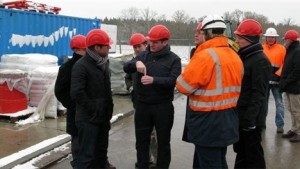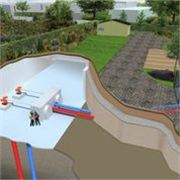
Taking the heat from under Ardwick
THINK ‘green energy’ and you probably think majestic wind turbines bestriding the landscape like an environmentally-friendly colossus. Or, ugly metal monsters desecrating the beauty of England’s green and pleasant land. Whichever way you look at it, those turbines don’t seem to see all that much action. For all the wind, there seem to be quite a few motionless rotors.
But now, a new project is off the ground to provide cheap green energy in Manchester. Energy that does not depend on the whim of wind or waves, or whether the sun wants to poke its nose out from behind a cloud. GT energy, a Dublin-based company, have plans to develop a geothermal heat generating facility just off Devonshire Road in Ardwick.
The company chose the site because it fulfils two key criteria. Firstly, the Cheshire Basin (and even though Manchester is traditionally Lancashire, that’s its name) has the right sort of geology, with sufficient depth to be able to harness enough heat and secondly, with the universities, hospitals, businesses and houses in and around the city centre, there is a huge demand for energy.
Managing Director of GT Energy, Padraig Hanly, is excited about the future of geothermal energy in the area: “The Cheshire Basin is a significant geothermal resource. We are hoping to roll out more projects in the region. There are 100,000 megawatts of geothermal energy waiting to be developed in the UK.”
Manchester City Council has given the go-ahead for the company to carry out detailed geological evaluations of the site. GT Energy will spend the next ten days carrying out a seismic acquisition survey to help them finalise their designs. This involves machines making small vibrations in the ground which are tracked to map the structure of the rock beneath, a bit like a sonic x-ray of the ground beneath our feet. If everything works out, the site could be up and running by 2016, making it the first of its kind in the UK.
Although Britain is a newcomer to the geothermal energy market, there have been plants up and running in Europe for years. There are around 40 similar projects in Paris whilst nine out of ten Icelandic households are heated by geothermal energy.
It’s no coincidence that since Orkustofnun (Iceland’s national energy authority) began to develop geothermal resources for the heating of homes after the Second World War, Iceland went from one of Europe’s poorest countries, to one of the most developed nations in the world with sky-high living standards.
Geothermal energy could make a real difference in stopping the astronomical rise of heating bills in future years. Because there is a constant supply, it means that customers won’t be held over an (oil) barrel due to fluctuations in energy markets.
This means longer term stable pricing but with all the infrastructure costs and capital investment, it doesn’t mean the end of energy bills. Ardwick residents will not be given the nod to discard the woolly jumpers, slip on the speedos and crank the heating all the way up to the max anytime soon.
Councillor Kate Chappell, Executive Member for environment said: “We welcome any innovative sources of safe, clean energy which would benefit Manchester residents and help us reduce the city’s carbon emissions.
“Geothermal energy, which has already been used successfully in other parts of Europe, is one possible alternative energy source and it would be very exciting if Manchester, the city where the Industrial Revolution began, was one of the first British cities to successfully use this technology.”
Geothermal energy comes from the heat at the earth’s core. This heat is a result of radioactive decay beneath the earth’s surface but that’s no reason to start worrying about men in white radiation suits strolling apocalyptically down the A6. The heat inside the earth’s core is naturally occurring and has been around since the formation of our planet.
The Science:
The heat from the earth’s core travels through the earth’s layers by conduction, heating underground water reservoirs and aquifers on its way. In order to make use of this natural heat source, two boreholes, each the width of a telegraph pole, will be drilled down to a depth of 3.2 kilometres beneath the earth’s surface because for every kilometre you travel towards the centre of the earth, temperatures increase by approximately 33°c, making the temperatures at this depth around 100°c.
A pump in the first well will pump hot water to the surface through a heat exchanger where the heat is extracted before the cooled water is returned to the earth via a second well.
By returning the used water to the limestone reservoir from whence it came, there should be a never-ending supply of hot water. And the cooled water won’t affect the hot water being pumped to the surface because even though the two boreholes will live together side-by-side in a well-head housing no bigger than a double garage, underneath the ground, they will go their own separate ways.
This well-head housing should be the only visible reminder of the technological revolution beneath our streets once the well-shafts have been drilled.
Admittedly, local residents will have to gaze on drilling rigs and the like while the site is being constructed but with the possibility of energy bills being drilled down a bit too, it might not seem such an eyesore after all.
Written by Jo Milligan.
